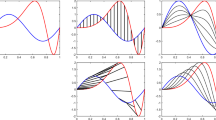Abstract
A number of global optimisation algorithms rely on the value of the Lipschitz constant of the objective function. In this paper we present a stochastic method for estimating the Lipschitz constant. We show that the largest slope in a fixed size sample of slopes has an approximate Reverse Weibull distribution. Such a distribution is fitted to the largest slopes and the location parameter used as an estimator of the Lipschitz constant. Numerical results are presented.
Similar content being viewed by others
References
Archetti, F., Betrò, B. and Steffè, S. (1976), “A theoretical framework for global optimisation via random sampling”, in Studies on Stochastic Optimization (Quaderno dei gruppi di recerca mathematica del C.N.R.), University of Pisa.
deHaanL. (1981), “Estimation of the minimum of a function using order statistics”, Journal of the American Statistical Association 76, 467–469.
GalambosJ. (1987), The Asymptotic Theory of Extreme Order Statistics, second edition, Krieger, Florida.
GnedenkoV.B. (1943), “Sur la distribution limite du terme maximum d'une série aléatoire”, Annals of Mathematics 44, 423–453.
GourdinE., HansenP. and JaumardB. (1994), “Finding maximum likelihood estimators for the three-parameter Weibull distribution”, J. Global Optimization 5, 373–397.
HansenP., JaumardB. and LuS.H. (1991), “On the number of iterations of Piyavskii's global optimization algorithm”, Mathematics of Operations Research 16, 334–350.
HansenP., JaumardB. and LuS.H. (1992), “On the use of estimates of the Lipschitz constant in global optimisation”, Journal of Optimization Theory and Applications 75, 195–200.
Horst, R. and Pardalos, P.M. (editors) (1995), Handbook of Global Optimization, Kluwer Academic Publishers.
MladineoR.H. (1986), “An algorithm for finding the global maximum of a multimodal, multivarieta function”, Mathematical Programming 34, 188–200.
MooreR.E. (1966), Interval Analysis, Prentice-Hall, Englewood Cliffs, N.J.
PanchangV.G. and GuptaR.C. (1989), “On the determination of three-parameter Weibull MLE's”, Communication in Statistics B: Simulation and Computation 18, 1037–1057.
RiordanJ. (1968), Combinatorial Identities, Wiley, New York.
ShubertB.O. (1972), “A sequential method seeking the global maximum of a function”, SIAM Journal on Numerical Analysis 9, 379–388.
StronginR.G. (1973), “On the convergence of an algorithm for finding a global extremum”, Engineering Cybernetics 11, 549–555.
TörnA. and ZilinskasA. (1989), “Global optimization”, Lecture Notes in Computer Science 350, Springer-Verlag, Berlin.
ZanakisS.H. and KyparisisJ. (1986), “A review of maximum likelihood estimation methods for the three-parameter Weibull distribution”, Journal of Statistical Computation and Simulation 25, 53–73.
Author information
Authors and Affiliations
Rights and permissions
About this article
Cite this article
Wood, G.R., Zhang, B.P. Estimation of the Lipschitz constant of a function. J Glob Optim 8, 91–103 (1996). https://doi.org/10.1007/BF00229304
Received:
Accepted:
Issue Date:
DOI: https://doi.org/10.1007/BF00229304




